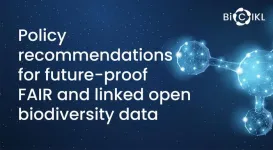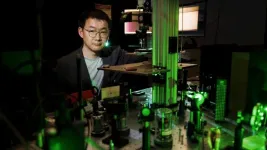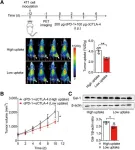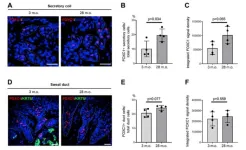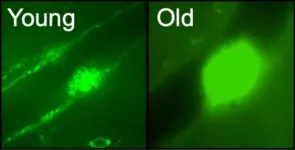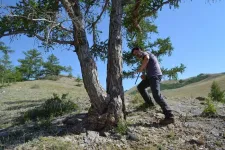(Press-News.org)
MEDIA INQUIRES
Laura Muntean
laura.muntean@ag.tamu.edu
601-248-1891
FOR IMMEDIATE RELEASE
$1 million grant project tackles economic, marketing gaps in U.S. aquaculture
Texas A&M AgriLife Research to co-lead National Oceanic and Atmospheric Administration grant project
by Sarah Fuller
Texas A&M AgriLife Research and institutions across the country will address critical economic and marketing gaps to strengthen the trajectory of the U.S. aquaculture industry with $1 million in support from the National Oceanic and Atmospheric Administration, NOAA, Sea Grant.
A $1 million grant from the National Oceanic and Atmospheric Administration will empower Texas A&M AgriLife Research and institutions across the U.S. to tackle economic and marketing gaps to strengthen the U.S. aquaculture industry. (Michael Miller/Texas A&M AgriLife)
Compared to other regions of the world, U.S. aquaculture production volumes are quite low, said Shraddha Hegde, Ph.D., assistant professor in the College of Agriculture and Life Sciences Department of Rangeland, Wildlife and Fisheries Management and project co-principal investigator.
Despite the U.S.’s abundant natural resources and coastlines, Hegde said domestic growth in the aquaculture industry has been slow. This lack of development is due in part to the difficulties of establishing an aquaculture operation and competition from imported seafood products.
“The challenges faced by U.S. aquaculture, from regulatory complexity and stringency to rising input costs, create a complex economic reality for producers,” said Jonathan van Senten, seafood economist at the Virginia Seafood Agricultural Research and Extension Center, assistant professor in the Department of Agricultural and Applied Economics at Virginia Tech, and principal investigator for the project.
Collaboration to provide critical market insight
The collaboration draws expertise from institutions across the nation, including Texas A&M University, Virginia Tech, Mississippi State University, University of Hawaii at Hilo, University of Maryland, University of Alaska, Morgan State University, Maine Aquaculture Association, University of Guam and University of Puerto Rico at Mayagüez.
Over the next two years, the team will establish the Aquaculture Economics and Markets Collaborative, which will provide producers and stakeholders with comprehensive economic and market research. This updated information will bolster data collected from previous NOAA Sea Grant-funded initiatives to capture the latest economic contributions of U.S. aquaculture.
Hegde said tools such as retail scanner data will allow the team to capture nuances of aquaculture product prices, distribution and promotion. In turn, researchers will be able to provide stakeholders with updated business planning tools encompassing greater coverage of more aquaculture species, regions and production systems throughout the U.S., including the Pacific Islands.
“This collaborative effort will build a strong network of information sharing between different universities,” Hegde said. “That allows us to generate a much broader view of the U.S. aquaculture industry while also providing producers with key information and resources.”
In addition to market research, the project will provide producer training through workshops across the U.S. Additionally, videos and training materials will be made publicly available in both English and Spanish via an economics and marketing portal on the Sea Grant Aquaculture Information Exchange managed by Virginia Sea Grant.
Geographic range of partners reflects scope of aquaculture diversity and production
According to the 2018 U.S. Census of Aquaculture, Texas ranks 11th for aquaculture sales. The top 11 states, each with $50 million or more in sales, accounted for over $1.2 billion of the total $1.5 billion in U.S. aquaculture sales that year.
While Texas’ neighboring states of Louisiana, Alabama, Mississippi and Florida are also included in this top production ranking, Gulf Coast aquaculture is by no means homogenous. Hegde said each state represents varying levels of industry maturity with distinct markets and unique production challenges.
“For example, Mississippi has a very established industry with a heavy focus on catfish production,” Hegde said. “Texas’ industry is currently smaller, and while we produce some catfish, we also focus on a number of other species, including redfish, shrimp, hybrid striped bass, sport and bait fish, and recently some oyster growers, too.”
Even in states like Mississippi and Hawaii with well-established aquaculture industries, Hegde and grant partners agree that existing studies have not accurately reflected the economic realities and nuances of the regions.
They believe this partnership connecting researchers, industry leaders and extension services across the U.S. is a key step in addressing this issue.
“Our goal is to provide much-needed economic information and resources to advance our domestic aquaculture industry as a sustainable, profitable and high-quality food system supporting both consumers and producers,” she said.
-30-
Would you like more information from Texas A&M AgriLife?
Visit AgriLife Today, the news hub for Texas A&M AgriLife, which brings together a college and four state agencies focused on agriculture and life sciences within The Texas A&M University System, or sign up for our Texas A&M AgriLife E-Newsletter.
For more resources including photo repository, logo downloads and style guidelines, please visit the Resources for Press and Media.
END
$1 million grant project tackles economic, marketing gaps in US aquaculture
Texas A&M AgriLife Research to co-lead National Oceanic and Atmospheric Administration grant project
2024-05-14
ELSE PRESS RELEASES FROM THIS DATE:
MIT researchers discover the universe’s oldest stars in our own galactic backyard
2024-05-14
MIT researchers, including several undergraduate students, have discovered three of the oldest stars in the universe, and they happen to live in our own galactic neighborhood.
The team spotted the stars in the Milky Way’s “halo” — the cloud of stars that envelopes the entire main galactic disk. Based on the team’s analysis, the three stars formed between 12 and 13 billion years ago, the time when the very first galaxies were taking shape.
The researchers have coined the stars ...
How to ensure biodiversity data are FAIR, linked, open and future-proof? Policy makers and research funders receive expert recommendations from the BiCIKL project
2024-05-14
Within the Biodiversity Community Integrated Knowledge Library (BiCIKL) project, 14 European institutions from ten countries, spent the last three years elaborating on services and high-tech digital tools, in order to improve the findability, accessibility, interoperability and reusability (FAIR-ness) of various types of data about the world’s biodiversity. These types of data include peer-reviewed scientific literature, occurrence records, natural history collections, DNA data and more.
By ensuring all those data are readily available and efficiently interlinked to each other, the project consortium’s intention is to provide better tools to the scientific community, ...
Lessons in chemistry: Guo aims at fundamental understanding of emerging semiconductor material
2024-05-14
Metal halide perovskites have emerged in recent years as a low-cost, highly efficient semiconducting material for solar energy, solid-state lighting and more. Despite their growing use, a fundamental understanding of the origins of their outstanding properties is still lacking. A Husker scientist is aiming to find answers that could lead to the development of new materials and new applications.
Yinsheng Guo, assistant professor of chemistry at the University of Nebraska–Lincoln, also wants to transform how physical chemistry is taught to undergraduate and graduate students, who often struggle to understand and apply what ...
Newly identified PET biomarker predicts success of immune checkpoint blockade therapy
2024-05-14
Reston, VA—The protein galectin-1 (Gal-1) has been identified as a new PET imaging biomarker for immune checkpoint blockade (ICB) therapy, allowing physicians to predict the tumor responses before beginning treatment. Information garnered from Gal-1 PET imaging could also be used to facilitate patient stratification and optimize immunotherapy, enabling targeted interventions and improving patient outcomes. This research was published in the May issue of The Journal of Nuclear Medicine.
Immunotherapies, such as ICB, have produced promising clinical ...
Age-associated gene expression changes in mouse sweat glands
2024-05-14
“In this study, we first obtained evidence that, in mouse, aging primarily reduced the number of active sweat glands.”
BUFFALO, NY- May 14, 2024 – A new research paper was published in Aging (listed by MEDLINE/PubMed as "Aging (Albany NY)" and "Aging-US" by Web of Science) Volume 16, Issue 8, entitled, “Characterization of age-associated gene expression changes in mouse sweat glands.”
Evaporation of sweat on the skin surface is the major mechanism for dissipating heat in humans. The secretory capacity of sweat glands (SWGs) ...
26-year-old heart transplant and stroke survivor named national champion for women’s health
2024-05-14
DALLAS, May 13, 2024 — Fewer than half of all women are aware that heart disease is their leading cause of death. That is why the American Heart Association, celebrating one hundred years of lifesaving service, created its community-based Woman of Impact™ initiative as an outgrowth of its year-round Go Red for Women® activist movement. The movement spotlights the lack of awareness and the clinical care gaps in women’s heart health. This year’s National Winner of the Go Red for Women 2024 Woman of Impart initiative is a 26-year-old heart transplant recipient, stroke survivor and American Heart Association local volunteer, Hana Hooper from Puget ...
Virus that causes COVID-19 can penetrate blood-retinal-barrier and could damage vision
2024-05-14
The blood-retinal barrier is designed to protect our vision from infections by preventing microbial pathogens from reaching the retina where they could trigger an inflammatory response with potential vision loss. But researchers at the University of Missouri School of Medicine have discovered the virus that causes COVID-19 can breach this protective retinal barrier with potential long-term consequences in the eye.
Pawan Kumar Singh, PhD, an assistant professor of ophthalmology, leads a team researching new ways to prevent and treat ocular infectious diseases. Using a humanized ...
Stem cells provide new insight into genetic pathway of childhood cancer
2024-05-14
Scientists have discovered a new insight into the genetic pathway of childhood cancer, offering new hope for tailored treatments.
Researchers from the University of Sheffield have created a stem cell model designed to investigate the origins of neuroblastoma, a cancer primarily affecting babies and young children.
Neuroblastoma is the most common childhood tumour occurring outside the brain, affecting the lives of approximately 600 children in the European Union and the United Kingdom each year.
Until now, studying genetic changes and their role in neuroblastoma initiation has been challenging due to the lack of suitable laboratory ...
Distinct population of ‘troublemaker’ platelet cells appear with aging, lead to blood clotting, disease
2024-05-14
As people age, they become more prone to blood clotting diseases, when blood cells called platelets clump together when they don’t need to and can cause major issues such as strokes and cardiovascular disease. For decades, scientists have studied why older people’s blood cells behave in this way, using their insights to develop the myriad of blood-thinning drugs now on the market for treating the leading cause of death in the United States.
Now, UC Santa Cruz Professor of Biomolecular Engineering Camilla Forsberg and her research group have ...
2023 was the hottest summer in two thousand years
2024-05-14
Researchers have found that 2023 was the hottest summer in the Northern Hemisphere in the past two thousand years, almost four degrees warmer than the coldest summer during the same period.
Although 2023 has been reported as the hottest year on record, the instrumental evidence only reaches back as far as 1850 at best, and most records are limited to certain regions.
Now, by using past climate information from annually resolved tree rings over two millennia, scientists from the University of Cambridge and the Johannes Gutenberg University Mainz have shown how exceptional the summer of 2023 was.
Even allowing for natural climate variations over hundreds of years, 2023 was still ...
LAST 30 PRESS RELEASES:
Heart-brain connection: international study reveals the role of the vagus nerve in keeping the heart young
Researchers identify Rb1 as a predictive biomarker for a new therapeutic strategy in some breast cancers
Survey reveals ethical gaps slowing AI adoption in pediatric surgery
Stimulant ADHD medications work differently than thought
AI overestimates how smart people are, according to HSE economists
HSE researchers create genome-wide map of quadruplexes
Scientists boost cell "powerhouses" to burn more calories
Automatic label checking: The missing step in making reliable medical AI
Low daily alcohol intake linked to 50% heightened mouth cancer risk in India
American Meteorological Society announces Rick Spinrad as 2026 President-Elect
Biomass-based carbon capture spotlighted in newly released global climate webinar recording
Illuminating invisible nano pollutants: advanced bioimaging tracks the full journey of emerging nanoscale contaminants in living systems
How does age affect recovery from spinal cord injury?
Novel AI tool offers prognosis for patients with head and neck cancer
Fathers’ microplastic exposure tied to their children’s metabolic problems
Research validates laboratory model for studying high-grade serous ovarian cancer
SIR 2026 delivers transformative breakthroughs in minimally invasive medicine to improve patient care
Stem Cell Reports most downloaded papers of 2025 highlight the breadth and impact of stem cell research
Oxford-led study estimates NHS spends around 3% of its primary and secondary care budget on the health impacts of heat and cold in England
A researcher’s long quest leads to a smart composite breakthrough
Urban wild bees act as “microbial sensors” of city health.
New study finds where you live affects recovery after a hip fracture
Forecasting the impact of fully automated vehicle adoption on US road traffic injuries
Alcohol-related hospitalizations from 2016 to 2022
Semaglutide and hospitalizations in patients with obesity and established cardiovascular disease
Researchers ‘listen in’ to embryo-mother interactions during implantation using a culture system replicating the womb lining
How changing your diet could help save the world
How to make AI truly scalable and reliable for real-time traffic assignment?
Beyond fragmented markets: A new framework for efficient and stable ride-pooling
Can shape priors make road perception more reliable for autonomous driving?
[Press-News.org] $1 million grant project tackles economic, marketing gaps in US aquacultureTexas A&M AgriLife Research to co-lead National Oceanic and Atmospheric Administration grant project

